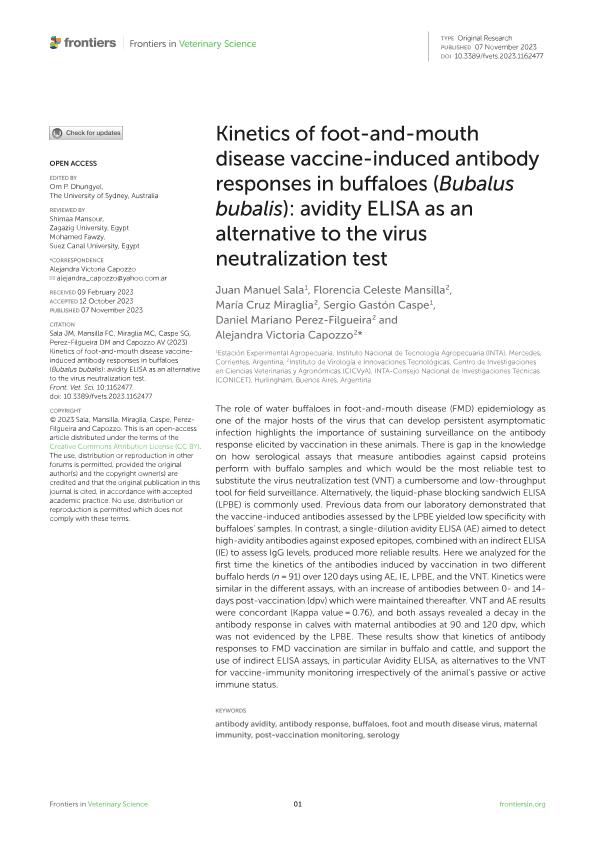Mostrar el registro sencillo del ítem
dc.contributor.author
Sala, Juan Manuel

dc.contributor.author
Mansilla, Florencia Celeste

dc.contributor.author
Miraglia, Maria Cruz

dc.contributor.author
Caspe, Sergio Gastón

dc.contributor.author
Pérez Filgueira, Daniel Mariano

dc.contributor.author
Capozzo, Alejandra Victoria

dc.date.available
2024-03-08T15:01:26Z
dc.date.issued
2023-12
dc.identifier.citation
Sala, Juan Manuel; Mansilla, Florencia Celeste; Miraglia, Maria Cruz; Caspe, Sergio Gastón; Pérez Filgueira, Daniel Mariano; et al.; Kinetics of foot-and-mouth disease vaccine-induced antibody responses in buffaloes (Bubalus bubalis): Avidity ELISA as an alternative to the virus neutralization test; Frontiers Media; Frontiers in Veterinary Science; 10; 1162477; 12-2023; 1-10
dc.identifier.uri
http://hdl.handle.net/11336/229865
dc.description.abstract
The role of water buffaloes in foot-and-mouth disease (FMD) epidemiology as one of the major hosts of the virus that can develop persistent asymptomatic infection highlights the importance of sustaining surveillance on the antibody response elicited by vaccination in these animals. There is gap in the knowledge on how serological assays that measure antibodies against capsid proteins perform with buffalo samples and which would be the most reliable test to substitute the virus neutralization test (VNT) a cumbersome and low-throughput tool for field surveillance. Alternatively, the liquid-phase blocking sandwich ELISA (LPBE) is commonly used. Previous data from our laboratory demonstrated that the vaccine-induced antibodies assessed by the LPBE yielded low specificity with buffaloes’ samples. In contrast, a single-dilution avidity ELISA (AE) aimed to detect high-avidity antibodies against exposed epitopes, combined with an indirect ELISA (IE) to assess IgG levels, produced more reliable results. Here we analyzed for the first time the kinetics of the antibodies induced by vaccination in two different buffalo herds (n = 91) over 120 days using AE, IE, LPBE, and the VNT. Kinetics were similar in the different assays, with an increase of antibodies between 0- and 14-days post-vaccination (dpv) which were maintained thereafter. VNT and AE results were concordant (Kappa value = 0.76), and both assays revealed a decay in the antibody response in calves with maternal antibodies at 90 and 120 dpv, which was not evidenced by the LPBE. These results show that kinetics of antibody responses to FMD vaccination are similar in buffalo and cattle, and support the use of indirect ELISA assays, in particular Avidity ELISA, as alternatives to the VNT for vaccine-immunity monitoring irrespectively of the animal’s passive or active immune status.
dc.format
application/pdf
dc.language.iso
eng
dc.publisher
Frontiers Media

dc.rights
info:eu-repo/semantics/openAccess
dc.rights.uri
https://creativecommons.org/licenses/by/2.5/ar/
dc.subject
ANTIBODY AVIDITY
dc.subject
ANTIBODY RESPONSE
dc.subject
BUFFALOES
dc.subject
FOOT AND MOUTH DISEASE VIRUS
dc.subject
MATERNAL IMMUNITY
dc.subject
POST-VACCINATION MONITORING
dc.subject
SEROLOGY
dc.subject.classification
Otras Ciencias Veterinarias

dc.subject.classification
Ciencias Veterinarias

dc.subject.classification
CIENCIAS AGRÍCOLAS

dc.title
Kinetics of foot-and-mouth disease vaccine-induced antibody responses in buffaloes (Bubalus bubalis): Avidity ELISA as an alternative to the virus neutralization test
dc.type
info:eu-repo/semantics/article
dc.type
info:ar-repo/semantics/artículo
dc.type
info:eu-repo/semantics/publishedVersion
dc.date.updated
2024-02-29T12:35:45Z
dc.identifier.eissn
2297-1769
dc.journal.volume
10
dc.journal.number
1162477
dc.journal.pagination
1-10
dc.journal.pais
Suiza

dc.journal.ciudad
Lausana
dc.description.fil
Fil: Sala, Juan Manuel. Instituto Nacional de Tecnología Agropecuaria. Centro Regional Corrientes. Estación Experimental Agropecuaria Mercedes; Argentina
dc.description.fil
Fil: Mansilla, Florencia Celeste. Instituto Nacional de Tecnología Agropecuaria. Centro de Investigación en Ciencias Veterinarias y Agronómicas. Instituto de Virología e Innovaciones Tecnológicas. - Consejo Nacional de Investigaciones Científicas y Técnicas. Oficina de Coordinación Administrativa Parque Centenario. Instituto de Virología e Innovaciones Tecnológicas; Argentina
dc.description.fil
Fil: Miraglia, Maria Cruz. Instituto Nacional de Tecnología Agropecuaria. Centro de Investigación en Ciencias Veterinarias y Agronómicas. Instituto de Virología e Innovaciones Tecnológicas. - Consejo Nacional de Investigaciones Científicas y Técnicas. Oficina de Coordinación Administrativa Parque Centenario. Instituto de Virología e Innovaciones Tecnológicas; Argentina
dc.description.fil
Fil: Caspe, Sergio Gastón. Instituto Nacional de Tecnología Agropecuaria. Centro Regional Corrientes. Estación Experimental Agropecuaria Mercedes; Argentina
dc.description.fil
Fil: Pérez Filgueira, Daniel Mariano. Instituto Nacional de Tecnología Agropecuaria. Centro de Investigación en Ciencias Veterinarias y Agronómicas. Instituto de Virología e Innovaciones Tecnológicas. - Consejo Nacional de Investigaciones Científicas y Técnicas. Oficina de Coordinación Administrativa Parque Centenario. Instituto de Virología e Innovaciones Tecnológicas; Argentina
dc.description.fil
Fil: Capozzo, Alejandra Victoria. Instituto Nacional de Tecnología Agropecuaria. Centro de Investigación en Ciencias Veterinarias y Agronómicas. Instituto de Virología e Innovaciones Tecnológicas. - Consejo Nacional de Investigaciones Científicas y Técnicas. Oficina de Coordinación Administrativa Parque Centenario. Instituto de Virología e Innovaciones Tecnológicas; Argentina
dc.journal.title
Frontiers in Veterinary Science
dc.relation.alternativeid
info:eu-repo/semantics/altIdentifier/doi/http://dx.doi.org/10.3389/fvets.2023.1162477
dc.relation.alternativeid
info:eu-repo/semantics/altIdentifier/url/https://www.frontiersin.org/articles/10.3389/fvets.2023.1162477/full
Archivos asociados
